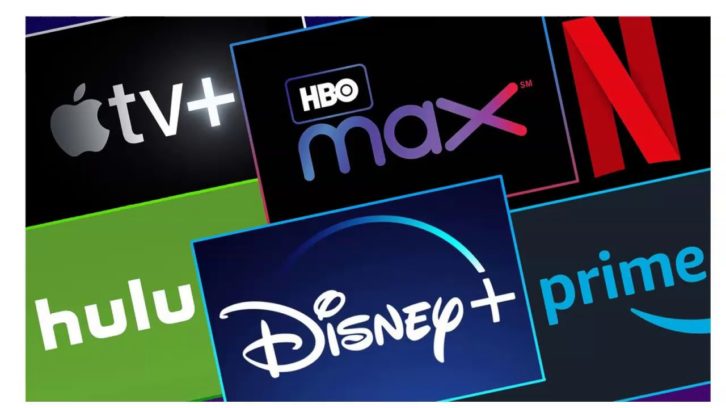In the second of our features looking at possible highlights and challenges for the media tech industry over the next 12 months, we focus on streaming and 5G.
Once again, we asked experts across the media tech industry to share their thoughts, with topics including the rise of sports streaming, FAST, low-latency, and the “greening of streaming”.
Streaming
Samira Bakhtiar, director, Global Media & Entertainment, AWS
Media and Entertainment (M&E) professionals are in the midst of an industry-wide transformation, as many content providers are reinventing the way they create content and compete for audience attention across streaming and direct-to-consumer (D2C) platforms. Industry leaders such as Netflix, NBCUniversal, HBO, Sky and Disney are turning to the cloud to pioneer new ways to entertain, expand their content catalogs, and set new audience experience paradigms for viewers. Faced with unprecedented audience demand for new entertainment, content providers will continue to rely heavily on remote production in the future as it opens up creative collaboration across the globe. As more companies explore the possibilities of cloud-based streaming technologies in the next year, we only anticipate the audience experience to grow richer.
Igor Oreper, chief architect at Bitmovin
The appetite for live event streaming will continue to grow significantly. As a result, the live event streaming tech will need updating and refactoring to become effective and meet demands.
The growth of video streaming beyond entertainment, in new media verticals such as eFitness and eLearning, will drive greater demand for cost-effective video streaming tools with minimal product development costs.
HDR will continue to dominate over 4K and 8K as it offers a more visually-appealing viewer experience at a lower cost. The only way 4K and 8K providers will be able to compete, is if they prioritise offering a more consistent and resilient viewer experience with improved startup times, reduced (re-)buffering, fewer errors – and all at a lower cost of service per viewer.
Rather than a breakthrough innovation, 2023 will see continued optimisations and improvements to existing video streaming tools that will result in higher service consistency, reliability, broader device reach and reduced cost.
Personalisation will be the one area of innovation that will stand out in 2023 – based on the development of more granular data insights on viewer wants and habits.
Marty Roberts, SVP, product strategy and marketing at Brightcove
Delivering content that meets viewers’ increasingly high expectations isn’t cheap. For many companies, the cost of streaming often means that scaling up your business will require you to scale down your quality. In an age where quality is a selling point, growing your business is quickly becoming a catch-22. But with bandwidth costs showing no signs of coming down anytime soon, waiting out the market isn’t really an option. If businesses want to scale their production without compromising video quality, they will need to invest in codec switching in 2023. For many years, delivery costs were the same for every customer, regardless of their available bandwidth. But why should you pay to deliver 4K video to every customer when many lack the bandwidth to stream it? With adaptive codec switching, companies won’t have to worry about this.
Xavier Leclercq, vice president of business development at Broadpeak
2023 will a year of transition to full IP streaming. Broadcasters like the BBC and service providers like Sky are planning to transition from broadcast to streaming over the next couple of years. As audiences shift to streaming services to follow their favourite content, we predict the momentum will carry across the TV industry. ITVX has illustrated that targeted advertising and the ability to reach engaged audiences through FAST offerings will be key drivers.
From a technology standpoint, we are already seeing Open Caching and multicast ABR used by telcos, in partnership with video providers, to scale video delivery on their networks. We envision that these technologies will enable a smooth transition to a full IP streaming in the coming years.
Furthermore, we think 5G and Fixed Wireless Access deployments and market adoption will continue in 2023, with video streaming being one of the most popular applications.
Robin Kirchhoffer, CMO at Dalet
The business has shifted. Previously, streaming was simply about the number of subscribers. Now, it has become a profits game. While subscription numbers will continue to be an essential metric, retaining subscribers and truly making money from each of them will prove to be the main competition of 2023. This means we are likely to see advertising on all major platforms, something already in motion at most high-profile OTT companies. With competition like never before, the amount of content produced will also be on the rise to increase subscriber retention. Streaming services are likely to see an explosion of sports content, with broadcasts accumulating an enormous volume of content before, during and after the game. The range of streaming scenarios and the massive amount of content flow is likely to result in companies needing to have advanced tech and automated workflows in place to manage it.
Eric Gallier, vice president, video customer solutions at Harmonic
The migration to the cloud we saw in 2022 will increase in pace in 2023. In particular, we foresee that a growing number of broadcasters will embrace using cloud and video streaming compared with on-premises infrastructure. Leveraging the cloud, service providers will be able to launch TV channels faster, with greater agility and flexibility.
As the streaming market expands, more companies will also turn to live event streaming to create new sources of revenue. The live streaming market is anticipated to be worth $4.26 billion by 2028.
We are already seeing a major shift of sports consumption away from broadcast TV toward streaming, and that trend will accelerate further in 2023. In the sports streaming market, one of the biggest challenges is scaling streaming services for high volumes of consumers on the fly. The cloud and SaaS solutions will be key to enabling growth of live event streaming, providing service providers with the capacity, agility, and flexibility to handle substantial traffic fluctuations and to ensure exceptional-quality video experiences.
Penny Westlake, senior director, Europe at Interra Systems
As we move into 2023, we expect growth in video streaming — especially FAST and AVoD services — to continue. Video service providers and operators will need to look for new ways to differentiate their offerings in order to stay competitive. High-quality video and flawless viewing experiences are not only standard expectations but also key factors in determining the success of streaming services. Media companies will need to up their efforts in 2023 to consistently provide an outstanding streaming experience for customers. This is driving the need for more efficient, advanced content preparation and delivery methods, sophisticated QC and monitoring systems, and ad revenue models. Given the crowded nature of the OTT environment, media companies will not be able to just use “status quo” tools to ensure a high QoE. They will need to keep up with the latest trends and innovations in media management to retain their USPs.
We think operators will increasingly turn to AI-/ML-driven solutions and migrate their critical operations to the cloud. In today’s post-pandemic world — with work-from-home and hybrid working models now normalised — accessing and managing software from anywhere will become a must. The cloud will play a large part in making this happen effectively. To consistently meet customers’ expectations for high QoE and QoS, service providers will need to easily access QC and monitoring systems at any location and on any device. This can significantly expedite problem identification and resolution, and, in turn, play a crucial role in maintaining subscriber satisfaction, driving customer engagement, and increasing profitability. Finding and implementing the best media QC and monitoring tools should be high on the agenda for operators and video service providers in 2023.
In addition, cost drivers are pushing media companies towards the consolidation of facilities. In 2023 this will fuel a greater demand for better QC and monitoring software that offers a more centralised overview of media – one that can look across multiple locations and services.
Jean-Christophe Pineault, sales manager, Sports, MediaKind
It’s no secret that 2022 was all about how the future of live sports streaming would play out. We have seen streaming platforms such as Amazon Prime, Apple, and Disney betting big on sporting entities, and 2023 will be no different as platforms aim to purchase more digital rights and shift content away from traditional broadcast environments. As OTT becomes a more standard means of delivery, we will likely see many other sports rights-holders opting for the direct-to-consumer (D2C) pathway as the next set of live rights deals come up for renewal and negotiation.

Linear-broadcast quality, viewing reliability, and highly scalable delivery are now expected from the streaming experience to satisfy the requirements of increasingly demanding sports audiences. The two-way nature of OTT delivery allows for a far richer and more immersive experience for fans than is possible with linear broadcast coverage. At the same time, it will enable rights-holders to gather valuable insights into their fans’ viewing behaviour and preference. In 2023, all D2C platforms will be focusing on fan engagement and finding ways to deepen the relationship between the audience and the brand. Of course, it begins with an ongoing focus on attracting and retaining subscribers and keeping eyeballs on the screen for the longest time possible – no small feat.
To do so will require a better understanding of what it takes to provide unique, data-driven offerings. That could be anything from content independent of the main broadcast (such as targeted highlights and multi-camera viewpoints) or a differentiated user experience (such as social media feeds overlaid in the video, betting odds, or fantasy games). More than ever, audiences in 2023 will want to personalise their experience and expect greater autonomy over how they watch their favourite sports.
Liam Hayter, senior solutions architect, NewTek
We expect to see the trajectory of distributed live production continue to evolve and develop across all content creation, and the space between traditional AV experiences and broadcast technologies overlap even further as a result.
Software-defined production technologies for live production, distribution, control and transmission are crucial in this unified space enabling more sources, better graphics, social media integration, automation and dynamic extended reality to any size production team, even self-service spaces – all delivered on commoditised Ethernet networks.
The 2020s started as a forced shift to remote and distributed communication and production, but 2023 is the year of agility, maturity and raising the bar of quality and engagement.
James Arnold, chief executive officer, Red Bee Media
Despite increasing demand, not even successful streaming services are immune to the strains of the current economic climate, with declining advertising revenues and challenges retaining subscribers. To stay ahead, content and rights owners are increasingly focused on maximising content returns across all distribution channels, whilst also driving efficiency in their operations. They are also shifting their focus to producing higher quality outputs to differentiate themselves from the competition and engage with their audiences. An example of this in 2022 has been the trend of launching FAST channels, offering more personalised and curated viewing experiences. Expect this to accelerate in 2023. Additionally, the media industry is placing far greater emphasis on environmental sustainability, with genuine efforts to adopt more responsible practices. As the demand for streaming continues to grow, the ‘greening of streaming’ has never been more important.
Ciro Noronha, Ph.D., RIST Forum
Let us broadly define “streaming” as “transporting real-time content over the Internet”. “Real-time” does not necessarily mean “live”, it just means that it is something that gets played in real-time on the other side. With this definition of “streaming”, we can use it for contribution and for distribution. Contribution cases include studio to studio, sports venue to studio, and similar cases. Contribution over the Internet has been a reality for many years; 2023 will see a lot more of that. The other aspect, distribution, refers to using the Internet to deliver content to end-users.
The “last” challenge there is latency for live events – as in, it has to be a lot less than it is now. We believe that 2023 will be the year where low-latency distribution solutions will become mainstream. Higher latency allows for smooth operation on marginal networks; as consumer Internet service gets better, there is an opening for lower latency operation. Our forecast is that the adoption of open, interoperable, and technically robust solutions for live video contribution/distribution over unmanaged networks will continue to grow.
Mike Shaw, director, international ad sales, Roku
As the cost of living continues to rise, ad-supported streaming is increasingly becoming a staple in most households’ media consumption. Roku has always believed in the value of access to free, premium content for streamers and recent changes from Netflix and Disney+ to introduce new tiers are accelerating the overall growth of ad-supported streaming. Media buyers in 2023 will be looking beyond traditional broadcasters as streaming attention grows and fragments further.
Oscar Gutierrez, VP business development, Switch Media
Alternative business models across the streaming technology sector are likely to become more widely seen in 2023, with a particular focus on AVoD. In countries where there is a high population and lots of scope for advertisers to create revenue, there are more opportunities for different business models between vendors and content owners such as revenue share deals: instead of paying the vendor a license fee for the use of the software, a percentage of the advertising revenue is paid instead. The consumer pays a small monthly fee (or no fee) for the AVoD service and has the option to purchase premium content such as movies that have just had their theatre release as and when required. AVoD services can also focus on local content, which is a huge value-add for consumers.

Gatis Gailis, CTO and founder, Veset
We are already seeing a dramatic shift in consumption habits. This is likely to accelerate further over the coming months. As consumers continue to see the impact of financial pressures, they will be looking to reduce outgoings and cutting back on streaming services is a simple way to do that. Many of the large providers have already recognised this launching ad tiers for their OTT services. This will all lead to a growing trend for ad-funded services, whether that is FAST channels, which are becoming increasingly popular, AVoD services, or an AVoD tier. This opens the door to other, more niche services, able to attract a bigger audience thanks to a consumer appetite to move to more ad-supported services. I believe we will therefore see more launches from smaller players and many of these gaining more ground than they have done so previously. There will also be a need for more personalisation and innovation to attract advertisers and deliver value.
Mathieu Planche, CEO at Witbe
With the streaming video landscape becoming increasingly overcrowded, the quality of experience received at home and on the go will become even more important to consumers in 2023. As dozens of different streaming platforms compete for viewers time and attention, consumers will prefer the services that deliver the best quality of viewing experience. Positively reviewed exclusive content will not be enough to entice viewers if they cannot experience the streaming quality level and cross-device performance they expect. To maintain subscribers and keep viewers loyal in 2023, streaming providers will need to carefully monitor their services across devices in order to deliver both strong content and outstanding video performance and quality.
5G
Williams Tovar – 5G media streaming solutions director, Ateme
In 2023 I expect we’ll start seeing some real benefits of 5G. The video streaming market will change in three main ways:
First, I expect to see an acceleration in trials and commercial deployments of 5G Stand Alone, enabling MNOs to open their 5G API to create disruptive business models with streaming services.
Second, viewers will finally see real xR and Metaverse applications accelerate. This will require network optimisations and low latency, relying on the 5G MEC architecture.
Third, MNOs will provide collective efforts towards reducing carbon emissions, and 5G will enable streaming optimisations to reduce energy consumption.

Mark Horchler, Haivision marketing director, products and solutions
Any discussion about live broadcasting trends for 2023 would be incomplete without 5G. Where 2022 saw the rollout of 5G transmitters on top of existing 4G core networks, 2023 is when 5G core networks will enable the technology to reach its full potential. As virtualised and cloud-native 5G core networks become increasingly available, dedicated network slices will offer broadcasters increased quality-of-service (QoS) and, in doing so, add a layer of reliability that makes live production over IP feasible for broadcasters, especially those that subscribe to a remote production model that leverages contribution over mobile networks. In addition to public networks, private 5G networks will expand broadcasters’ capabilities within venues by replacing cables and WiFi for more flexible options for capturing live video. 2023 will mark a new phase of 5G where we can expect even more bandwidth, lower latency, and widespread transition to IP and cloud-based broadcast production workflows.
Ronen Artman, VP marketing, LiveU
The impact of 5G will continue to grow as the networks are deployed in more regions worldwide. We continue to be actively engaged in the ongoing development and deployment of 5G-native solutions.
High-quality streams and super low latency enabled by 5G networks make remote production even more viable and facilitate more high-end productions with superior quality, synchronised 4K and multi-camera productions. What is clear is that bonding is still essential when it comes to maximising the reliability of 5G use. 5G does come with it limitations, indoor use being a prime example and bonding provides the solution.
Christof Haslauer, CEO, NativeWaves
5G will change how content is produced. From content capture using cameras using 5G technology, accelerated adoption of Hybrid workflows to user-generated content from venues becoming an integral part of broadcast production, 5G will transform how content in created.
The growth of 5G, especially in stadia, will spawn a whole new range of experiences that will be offered to fans at events. From instant replays, immediate access to data analytics on the game to additional e-commerce opportunities, Venue owners will use the power of 5G to explore new revenue opportunities and enhance the fans experience in-stadia.
Mohamed Aziz Taga, head business development and strategy 5G Media Services, Rohde & Schwarz
I believe 5G holds the promise of original technological and business opportunities enabling a more sustainable and better-connected world. In 2023, we’ll see 5G technology bringing new broadcast and multicast capabilities to the entire wireless ecosystem while creating high spectral and energy efficiency, and reduced costs. It also commits to a safer world with improved public safety features during critical situations where it helps simplify the relationship between citizens and public authorities. The fact is, broadcast/multicast over 5G is not only restricted to linear and live content distribution. The exciting thing about this is, for network operators and media content providers, it means a completely new range of business models are now possible for delivering content or data to large numbers of consumers without affecting the regular cellular 5G mobile network. I think this year we will witness new consumer applications, particularly in the venue and automotive sectors. In 2023 I see new and exciting possibilities where 5G Broadcasting is a gamechanger, it is the future of media delivery, and on top of all that, it also scales with unprecedented efficiency and reliability.








